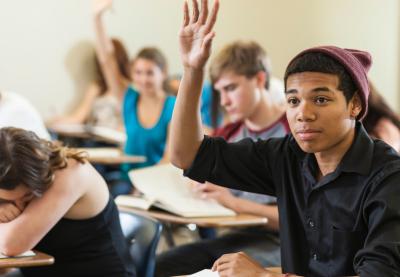Every month, we report on incidents of hate that made news at schools across the nation. To help educators become better allies, we observe trends and pay special attention to who is targeted. We know students are bullied, taunted and even physically attacked at school because of their identities—not just by their peers but sometimes by teachers and other adults.
We know that some hate incidents affect students who have multiple marginalized identities. These events usually manifest as a hodgepodge of racial slurs and graffiti and, occasionally, physical violence. In November 2018, for example, we counted at least seven events that included a mix of homophobia, racism, anti-Semitism, Islamophobia and anti-immigrant rhetoric; six more combined racism and anti-Semitism. That trend continued in December, with eight incidents attacking intersectional identities.
We know that LGBTQ students are more likely to attempt suicide, but some LGBTQ students of color are at an even higher risk: Latinx and Native/Pacific Islander LGBTQ youth have a significantly higher prevalence of suicide attempts, according to a 2014 study published in the American Journal of Public Health.
We also know that hate crimes are on the rise, according to the most current FBI statistics, and black LGBTQ people are disproportionately affected. Anti-black hate crimes rose by 16 percent in 2017, and anti-LGBTQ hate crimes rose by 3 percent.
The National Coalition of Anti-Violence Programs tracks hate-related homicides of LGBTQ people. In 2017, it reports, black people comprised 60 percent of the victims.
This means that if you are black and LGBTQ, you’re at a higher risk of harm at any turn. Black LGBTQ people continuously fight to be seen and affirmed in both black and LGBTQ communities. It sometimes means, for the sake of safety, hiding a part of who you are in certain spaces. It’s how many people—an estimated one million—navigate through life daily.
It doesn’t help that black LGBTQ people face unique injustices in many states—usually states with larger concentrations of people who identify as such. There is still not enough protection in a world that devalues lives deemed “other.”
This intersectionality—the social, economic and political ways in which identity-based systems of oppression and privilege connect and influence one another—creates physical, emotional and mental harm for many black queer people. For example, they are more likely to face economic insecurity, violence, harassment, health inequity and religious intolerance—and often, they don’t receive justice for any of it.
What Can Educators Do?
When discussions about hate come up in the classroom, it’s important that teachers emphasize intersectionality. While we are calling attention to the intersection of race and sexual identity, we shouldn’t forget to also support and embrace the value in other intersections—from ability and gender to religious belief and class.
We should encourage students to strive to be better allies by directly acknowledging and addressing how privilege contributes to oppressive systems at school and in their community. We can help students recognize that ignoring one part of a person’s identity is an erasure of their lived experience.
It’s also important to teach at these intersections. That means we have to be aware of any race-, gender-, ability- or class-related circumstances that may affect students’ academic performance, behavior or well-being.
“Teaching at the Intersections” explains how you can create a safe space for students to open discussions about their identities and to share if they’ve experienced judgment or bias based on those identities. An accompanying video, “Intersectionality 101,” is a great primer for students of all ages.
To prevent violence, we must instill in young people the value of embracing each other’s distinct identities—all of them. Schools should serve as the ideal place to learn how to participate in effective debates and respectfully engage in public discourse—instead of learning to hate.
See our School Climate Resources for tools, protocols and practical advice for making your school more open and welcoming to all students.
This is why it’s important for teachers and other staff to disrupt hateful incidents as they occur and follow through with actionable steps to prevent future incidents.
Our guide Best Practices for Serving LGBTQ Students provides a comprehensive look into how educators can support all LGBTQ students in their schools.
By building classroom and school cultures that affirm all identities, guiding classroom discussions where students learn to be allies and leading the fight against hate within our communities, we can create an environment, inside and outside of school, where people of all identities can safely be themselves.
Dillard is the staff writer for Teaching Tolerance.
Editor's note: This article was originally published on January 31 in response to the alleged assault on activist and entertainer Jussie Smollett. He was charged with disorderly conduct for filing a false police report, charges which were dropped in March. We understand the significance of this context for readers, and we want to reaffirm the central premise of this piece: Interlocking systems of oppression make life more difficult—and less safe—for black LGBTQ people and others with marginalized identities. It is our work as educators to build classroom and school cultures that affirm all of our students.
